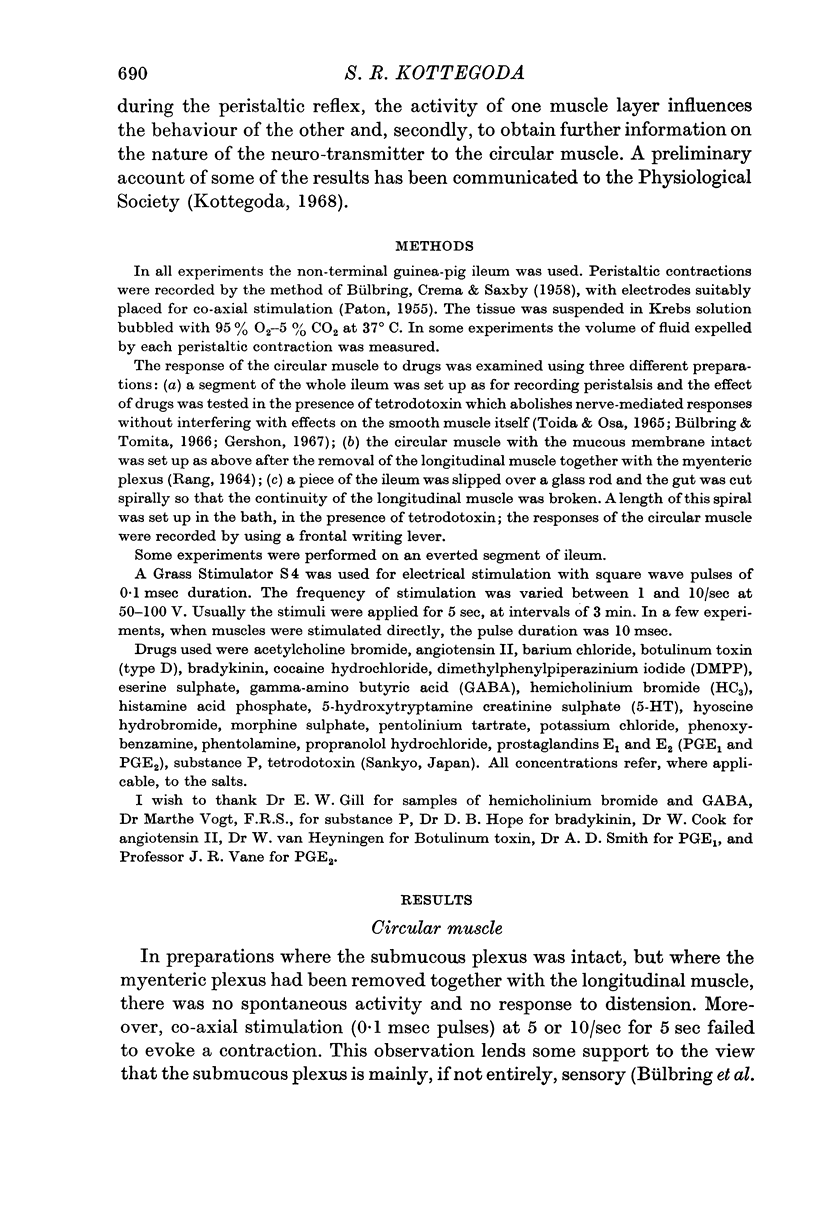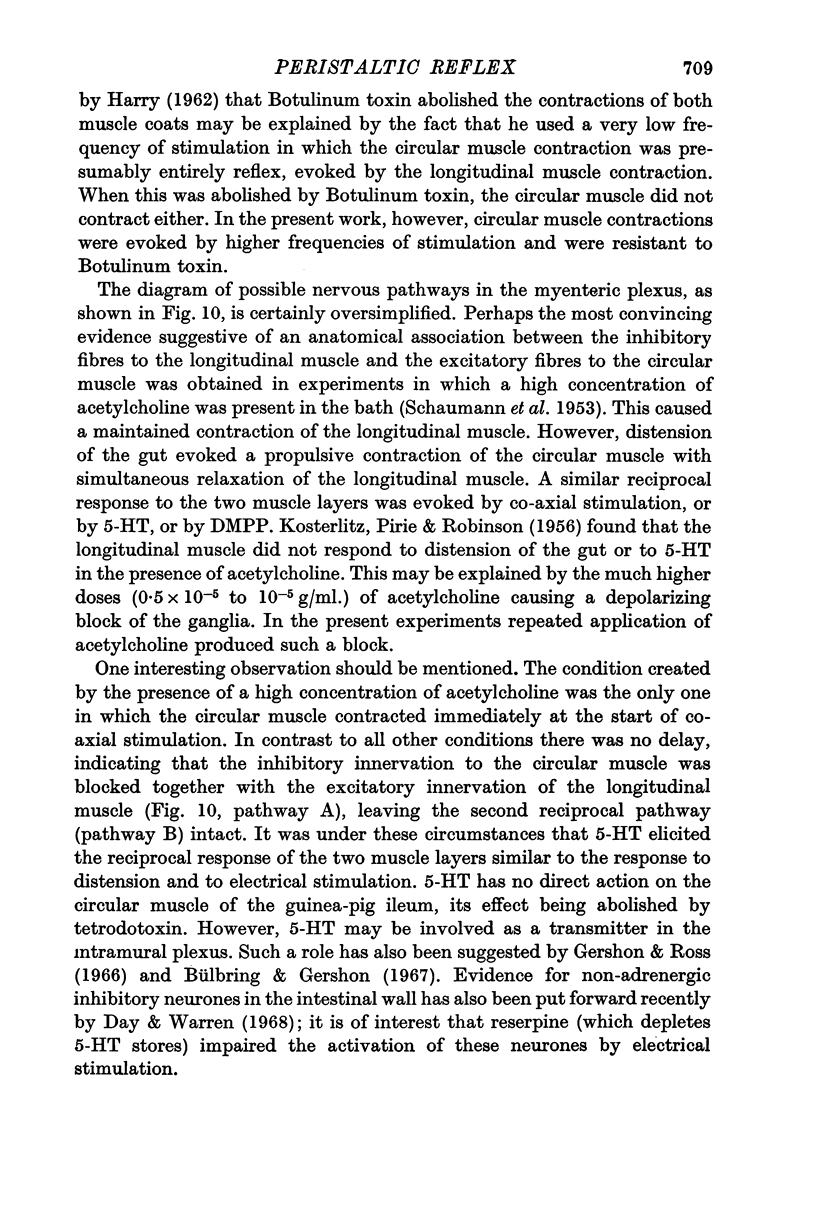Abstract
1. The effects of drugs on peristalsis and on the contractions of the two muscle coats of the isolated guinea-pig ileum in response to co-axial electrical stimulation have been studied.
2. Co-axial stimulation (0·1 msec pulses) never produces simultaneous contraction of both muscle coats. When one muscle contracts, the other either relaxes or remains quiescent.
3. The circular muscle contraction has two components. The first is reflex in origin and is brought about either by distension of the gut with increasing intraluminal filling or by the contraction of the longitudinal muscle in response to electrical stimulation at low frequency (1/sec), provided this raises the intraluminal pressure to the threshold for eliciting the circular muscle contraction. As the circular muscle contracts, the longitudinal muscle relaxes although stimulation continues. If the circular muscle contraction is prevented by reducing the intraluminal filling, or by adding a ganglion-blocking drug, the longitudinal muscle remains contracted until withdrawal of the stimulus.
4. In the presence of hyoscine, the reflex contraction of the circular muscle is unimpaired but, since the longitudinal muscle contraction is abolished, a higher intraluminal pressure is required to elicit the reflex.
5. The second component of the circular muscle contraction appears in response to electrical stimulation at high frequency (3-10/sec), upon withdrawal of electrical stimulation. This delay indicates the simultaneous stimulation of a dominant inhibitory innervation.
6. The excitatory nerves to the circular muscle require a higher frequency of stimulation than those to the longitudinal muscle, which respond to single shocks.
7. Cholinergic blocking agents (hyoscine, morphine, hemicholinium and botulinum toxin) antagonize the responses of the longitudinal muscle to co-axial stimulation without affecting those of the circular muscle, thus suggesting that the excitatory fibres to the circular muscle are not cholinergic. Prostaglandins (E1 and E2) selectively antagonize the circular muscle contractions evoked by co-axial stimulation. Tetrodotoxin blocks both longitudinal and circular muscle responses.
8. Dimethylphenylpiperazinium (DMPP) and 5-hydroxytryptamine (5-HT) stimulate ganglia but have no direct action on the smooth muscle of guinea-pig ileum.
9. During a maintained contraction of the longitudinal muscle in the presence of high concentrations of acetylcholine (2·5 × 10-7 to 10-6 g/ml.) a contraction of the circular muscle accompanied by a relaxation of the longitudinal muscle is elicited by distension of the gut, and by co-axial stimulation. Similar reciprocal responses are produced by 5-HT or by DMPP and they are finally blocked by DMPP.
10. These results are consistent with the hypothesis that in the myenteric plexus there exists an arrangement of nerves which ensures that the two muscle coats of the intestine do not contract simultaneously but are activated reciprocally so that when one muscle layer contracts the other relaxes or is prevented from contracting.
Full text
PDF

























Selected References
These references are in PubMed. This may not be the complete list of references from this article.
- AMBACHE N., LESSIN A. W. Classification of intestinomotor drugs by means of type D botulinum toxin. J Physiol. 1955 Mar 28;127(3):449–478. doi: 10.1113/jphysiol.1955.sp005270. [DOI] [PMC free article] [PubMed] [Google Scholar]
- AMBACHE N., ROBERTSON P. A. The nicotine-like actions of the 3-bromo-and 3:5-dibromo-phenyl ethers of choline (MBF and DBF). Br J Pharmacol Chemother. 1953 Jun;8(2):147–155. doi: 10.1111/j.1476-5381.1953.tb00769.x. [DOI] [PMC free article] [PubMed] [Google Scholar]
- AMBACHE N. Unmasking, after cholinergic paralysis by botulinum toxin, of a reversed action of nicotine on the mammalian intestine, revealing the probable presence of local inhibitory ganglion cells in the enteric plexuses. Br J Pharmacol Chemother. 1951 Mar;6(1):51–67. doi: 10.1111/j.1476-5381.1951.tb00619.x. [DOI] [PMC free article] [PubMed] [Google Scholar]
- BELESLIN D., VARAGIC V. The effect of substance P on the peristaltic reflex of the isolated guinea-pig ileum. Br J Pharmacol Chemother. 1958 Sep;13(3):321–325. doi: 10.1111/j.1476-5381.1958.tb00911.x. [DOI] [PMC free article] [PubMed] [Google Scholar]
- BIRKS R. I., MACINTOSH F. C., SASTRY P. B. Pharmacological inhibition of acetylcholine synthesis. Nature. 1956 Nov 24;178(4543):1181–1181. doi: 10.1038/1781181a0. [DOI] [PubMed] [Google Scholar]
- BROWNLEE G., HARRY J. SOME PHARMACOLOGICAL PROPERTIES OF THE CIRCULAR AND LONGITUDINAL MUSCLE STRIPS FROM THE GUINEA-PIG ISOLATED ILEUM. Br J Pharmacol Chemother. 1963 Dec;21:544–554. doi: 10.1111/j.1476-5381.1963.tb02022.x. [DOI] [PMC free article] [PubMed] [Google Scholar]
- BROWNLEE G., JOHNSON E. S. THE RELEASE OF ACETYLCHOLINE FROM THE ISOLATED ILEUM OF THE GUINEA-PIG INDUCED BY 5-HYDROXYTRYPTAMINE AND DIMETHYLPHENYLPIPERAZINIUM. Br J Pharmacol Chemother. 1965 Jun;24:689–700. doi: 10.1111/j.1476-5381.1965.tb01624.x. [DOI] [PMC free article] [PubMed] [Google Scholar]
- BULBRING E., LIN R. C., SCHOFIELD G. An investigation of the peristaltic reflex in relation to anatomical observations. Q J Exp Physiol Cogn Med Sci. 1958 Jan;43(1):26–37. doi: 10.1113/expphysiol.1958.sp001305. [DOI] [PubMed] [Google Scholar]
- BULBRING E., LIN R. C. The effect of intraluminal application of 5-hydroxytryptamine and 5-hydroxytryptophan on peristalsis; the local production of 5-HT and its release in relation to intraluminal pressure and propulsive activity. J Physiol. 1958 Mar 11;140(3):381–407. [PMC free article] [PubMed] [Google Scholar]
- Bayliss W. M., Starling E. H. The movements and innervation of the small intestine. J Physiol. 1899 May 11;24(2):99–143. doi: 10.1113/jphysiol.1899.sp000752. [DOI] [PMC free article] [PubMed] [Google Scholar]
- Bennett A., Friedmann C. A., Vane J. R. Release of prostaglandin E-1 from the rat stomach. Nature. 1967 Dec 2;216(5118):873–876. doi: 10.1038/216873a0. [DOI] [PubMed] [Google Scholar]
- Bennett A., Murray J. G., Wyllie J. H. Occurrence of prostaglandin E2 in the human stomach, and a study of its effects on human isolated gastric muscle. Br J Pharmacol Chemother. 1968 Feb;32(2):339–349. [PubMed] [Google Scholar]
- Bennett M. R., Burnstock G., Holman M. Transmission from intramural inhibitory nerves to the smooth muscle of the guinea-pig taenia coli. J Physiol. 1966 Feb;182(3):541–558. doi: 10.1113/jphysiol.1966.sp007836. [DOI] [PMC free article] [PubMed] [Google Scholar]
- Burnstock G., Campbell G., Rand M. J. The inhibitory innervation of the taenia of the guinea-pig caecum. J Physiol. 1966 Feb;182(3):504–526. doi: 10.1113/jphysiol.1966.sp007834. [DOI] [PMC free article] [PubMed] [Google Scholar]
- Bülbring E., Gershon M. D. 5-hydroxytryptamine participation in the vagal inhibitory innervation of the stomach. J Physiol. 1967 Oct;192(3):823–846. doi: 10.1113/jphysiol.1967.sp008334. [DOI] [PMC free article] [PubMed] [Google Scholar]
- Bülbring E., Tomita T. Properties of the inhibitory potential of smooth muscle as observed in the response to field stimulation of the guinea-pig taenia coli. J Physiol. 1967 Apr;189(2):299–315. doi: 10.1113/jphysiol.1967.sp008169. [DOI] [PMC free article] [PubMed] [Google Scholar]
- DAY M., VANE J. R. An analysis of the direct and indirect actions of drugs on the isolated guinea-pig ileum. Br J Pharmacol Chemother. 1963 Feb;20:150–170. doi: 10.1111/j.1476-5381.1963.tb01306.x. [DOI] [PMC free article] [PubMed] [Google Scholar]
- Day M. D., Warren P. R. A pharmacological analysis of the responses to transmural stimulation in isolated intestinal preparations. Br J Pharmacol Chemother. 1968 Feb;32(2):227–240. doi: 10.1111/j.1476-5381.1968.tb00967.x. [DOI] [PMC free article] [PubMed] [Google Scholar]
- Gershon M. D. Effects of tetrodotoxin on innervated smooth muscle preparations. Br J Pharmacol Chemother. 1967 Mar;29(3):259–279. doi: 10.1111/j.1476-5381.1967.tb01958.x. [DOI] [PMC free article] [PubMed] [Google Scholar]
- Gershon M. D., Ross L. L. Location of sites of 5-hydroxytryptamine storage and metabolism by radioautography. J Physiol. 1966 Oct;186(2):477–492. doi: 10.1113/jphysiol.1966.sp008047. [DOI] [PMC free article] [PubMed] [Google Scholar]
- HARRY J. Effect of cooling, local anaesthetic compounds and botulinum toxin on the responses of and the acetylcholine output from the electrically transmurally stimulated isolated guinea-pig ileum. Br J Pharmacol Chemother. 1962 Aug;19:42–55. doi: 10.1111/j.1476-5381.1962.tb01425.x. [DOI] [PMC free article] [PubMed] [Google Scholar]
- HARRY J. The action of drugs on the circular muscle strip from the guinea-pig isolated ileum. Br J Pharmacol Chemother. 1963 Jun;20:399–417. doi: 10.1111/j.1476-5381.1963.tb01478.x. [DOI] [PMC free article] [PubMed] [Google Scholar]
- KOSTERLITZ H. W., LEES G. M. PHARMACOLOGICAL ANALYSIS OF INTRINSIC INTESTINAL REFLEXES. Pharmacol Rev. 1964 Sep;16:301–339. [PubMed] [Google Scholar]
- KOSTERLITZ H. W., PIRIE V. W., ROBINSON J. A. The mechanism of the peristaltic reflex in the isolated guinea-pig ileum. J Physiol. 1956 Sep 27;133(3):681–694. doi: 10.1113/jphysiol.1956.sp005618. [DOI] [PMC free article] [PubMed] [Google Scholar]
- KOSTERLITZ H. W., ROBINSON J. A. Inhibition of the peristaltic reflex of the isolated guinea-pig ileum. J Physiol. 1957 Apr 30;136(2):249–262. doi: 10.1113/jphysiol.1957.sp005757. [DOI] [PMC free article] [PubMed] [Google Scholar]
- KOSTERLITZ H. W., ROBINSON J. A. Reflex contractions of the longitudinal muscle coat of the isolated guinea-pig ileum. J Physiol. 1959 May 19;146(2):369–379. doi: 10.1113/jphysiol.1959.sp006198. [DOI] [PMC free article] [PubMed] [Google Scholar]
- Kosterlitz H. W. Intrinsic intestinal reflexes. Am J Dig Dis. 1967 Mar;12(3):245–254. doi: 10.1007/BF02233642. [DOI] [PubMed] [Google Scholar]
- Kottegoda S. R. Are the excitatory nerves to the circular muscle of the guinea-pig ileum cholinergic? J Physiol. 1968 Jul;197(1):17P–18P. [PubMed] [Google Scholar]
- Langley J. N., Magnus R. Some observations of the movements of the intestine before and after degenerative section of the mesenteric nerves. J Physiol. 1905 Sep 8;33(1):34–51. doi: 10.1113/jphysiol.1905.sp001108. [DOI] [PMC free article] [PubMed] [Google Scholar]
- PATON W. D. M., ZAIMIS E. J. The pharmacological actions of polymethylene bistrimethyl-ammonium salts. Br J Pharmacol Chemother. 1949 Dec;4(4):381–400. doi: 10.1111/j.1476-5381.1949.tb00565.x. [DOI] [PMC free article] [PubMed] [Google Scholar]
- PATON W. D. The action of morphine and related substances on contraction and on acetylcholine output of coaxially stimulated guinea-pig ileum. Br J Pharmacol Chemother. 1957 Mar;12(1):119–127. doi: 10.1111/j.1476-5381.1957.tb01373.x. [DOI] [PMC free article] [PubMed] [Google Scholar]
- PATON W. D. The response of the guineapig ileum to electrical stimulation by coaxial electrodes. J Physiol. 1955 Feb 28;127(2):40–1P. [PubMed] [Google Scholar]
- PATON W. D., VANE J. R. Analysis of he responses of the isolated stomach to electrical stimulation and to drugs. J Physiol. 1963 Jan;165:10–46. doi: 10.1113/jphysiol.1963.sp007040. [DOI] [PMC free article] [PubMed] [Google Scholar]
- RANG H. P. STIMULANT ACTIONS OF VOLATILE ANAESTHETICS ON SMOOTH MUSCLE. Br J Pharmacol Chemother. 1964 Apr;22:356–365. doi: 10.1111/j.1476-5381.1964.tb02040.x. [DOI] [PMC free article] [PubMed] [Google Scholar]
- SCHAUMANN O., JOCHUM K., SCHMIDT H. Analgetika und Darmmotorik. III. Zum Mechanismus der Peristaltik. Naunyn Schmiedebergs Arch Exp Pathol Pharmakol. 1953;219(4):302–309. [PubMed] [Google Scholar]
- TRENDELENBURG U. Modification of transmission through the superior cervical ganglion of the cat. J Physiol. 1956 Jun 28;132(3):529–541. doi: 10.1113/jphysiol.1956.sp005546. [DOI] [PMC free article] [PubMed] [Google Scholar]
- TRENDELENBURG U. The action of 5-hydroxytryptamine on the nictitating membrane and on the superior cervical ganglion of the cat. Br J Pharmacol Chemother. 1956 Mar;11(1):74–80. doi: 10.1111/j.1476-5381.1956.tb01031.x. [DOI] [PMC free article] [PubMed] [Google Scholar]
- WONG K. C., LONG J. P. Autonomic blocking properties of hemicholinium (HC-3). J Pharmacol Exp Ther. 1961 Aug;133:211–215. [PubMed] [Google Scholar]


